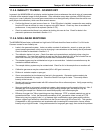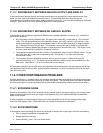
Teledyne API - Model 200EH/EM Operation Manual Troubleshooting & Repair
247
Check for disconnected cables to the sensor module.
Carry out an electrical test with the
ELECTRICAL TEST procedure in the diagnostics menu, see Section
6.13.7.3. If this test produces a concentration reading, the analyzer’s elec
tronic signal path is correct.
Carry out an optical test using the
OPTIC TEST procedure in the diagnostics menu, see Section
6.13.6.2. If this test results in a concentration signal, then the PMT sensor and the electronic signal path
are operating properly. If the M200EH/EM passes both ETEST and OTEST, the instrument is capable
of detecting light and processing the signal to produce a reading. Therefore, the problem must be in the
pneumatics or the ozone generator.
If NO
2
signal is zero while NO signal is correct, check the NO/NO
X
valve and the NO
2
converter for
proper operation.
11.3.3. UNSTABLE ZERO AND SPAN
Leaks in the M200EH/EM or in the external gas supply and vacuum systems are the most common source of
unstable and non-repeatable concentration readings.
Check for leaks in the pneumatic systems as described in Section 0. Consider pneumatic components
in the gas delivery system outside the M200EH/EM such a
s a change in zero air source (ambient air
leaking into zero air line or a worn-out zero air scrubber) or a change in the span gas concentration due
to zero air or ambient air leaking into the span gas line.
Once the instrument passes a leak check, do a flow check (this chapter) to make sure that the
instrument is supplied with adequate sample and ozone air.
Confirm the sample pressure, sample temperature, and sample flow readings are correct and steady.
Verify that the sample filter element is clean and does not need to be replaced.
11.3.4. INABILITY TO SPAN - NO SPAN KEY
In general, the M200EH/EM will not display certain keyboard choices whenever the actual value of a parameter
is outside of the expected range for that parameter. If the calibration menu does not show a SPAN key when
carrying out a span calibration, the actual concentration must be outside of the range of the expected span gas
concentration, which can have several reasons.
Verify that the expected concentration is set properly to the actual span gas concentration in the
CONC
sub-menu.
Confirm that the NO
x
span gas source is accurate. This can be done by comparing the source with
another calibrated analyzer, or by having the NO
x
source verified by an independent traceable
photometer.
Check for leaks in the pneumatic systems as described in Section 0. Leaks can dilute the span gas and,
hence, the concentration that the analyzer meas
ures may fall short of the expected concentration
defined in the
CONC sub-menu.
If the low-level, hardware calibration has drifted (changed PMT response) or was accidentally altered by
the user, a low-level calibration may be necessary to get the analyzer back into its proper range of
expected values. One possible indicator of this scenario is a slope or offset value that is outside of its
allowed range (0.7-1.3 for slope, -20 to 150 for offsets). See Section 11.6.5 on how to carry out a low-
level hardw
are calibration.
04521C (DCN5731)


















